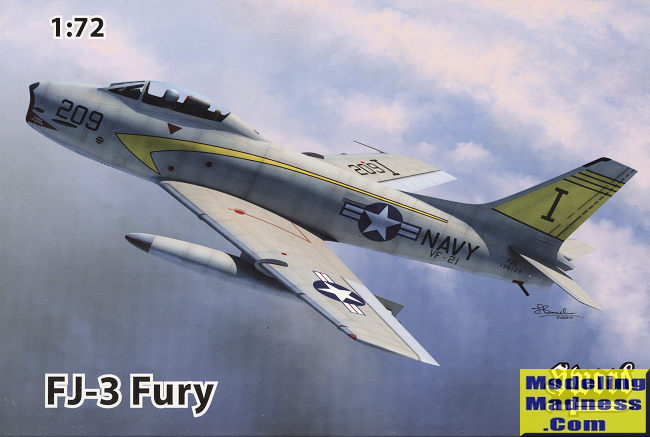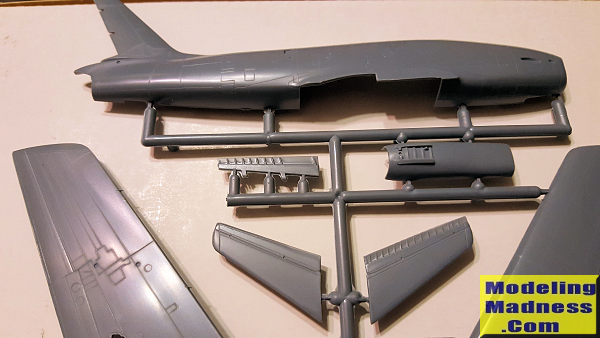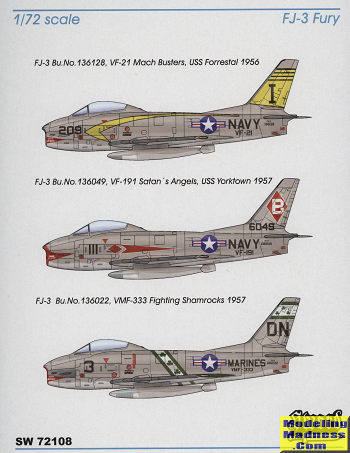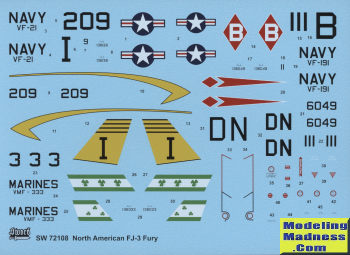
Sword 1/72 FJ-3 Fury
| KIT #: | SW 72108 |
| PRICE: | $18.00 plus shipping |
| DECALS: | Three options |
| REVIEWER: | Scott Van Aken |
| NOTES: | Short run kit with resin parts. 2017 tooling. |

| HISTORY |
The North American FJ-2 and FJ-3 Fury were a series of swept-wing carrier-capable fighters for the United States Navy and Marine Corps. The FJ-2 resulted from an effort to navalize the United States Air Force's F-86 Sabre. These aircraft featured folding wings, and a longer nose landing strut designed to increase angle of attack upon launch and to accommodate a longer oleo to absorb the shock of hard landings on an aircraft carrier deck.
Although sharing a U.S. Navy designation with its distant predecessor, the straight-winged North American FJ-1 Fury, the FJ-2/-3 were completely different aircraft. (The later FJ-4 Fury was, again, a complete structural redesign of the FJ-3). The FJ-2 was one of the aircraft used to evaluate the first steam catapult on a US Navy aircraft-carrier.
Even while development of the FJ-2 was ongoing, the development was planned of a version powered by the Wright J65, a license-built version of the British Armstrong Siddeley Sapphire turbojet. The Sapphire promised to deliver 28% more thrust than the J47, for little gain in weight. The new version was designated FJ-3, and an order for 389 aircraft was placed in March 1952.
To test the new engine a single FJ-2, BuNo 131931, was modified, but the first true production FJ-3 flew on 3 July 1953. The only externally visible change required by the new engine was a deeper intake to accommodate the larger mass flow. Early FJ-3s had the same wing as the FJ-2, but from 1955 onwards the FJ-3 was built with a so-called "6-3" wing, with a leading edge that was extended 6 inches at the root and 3 inches at the tip. This modification, first introduced on the F-86F, enhanced maneuverability at the price of a small increase in landing speed because the leading edge slats were deleted. The version introduced on the FJ-3 was different from that fitted to the F-86F, as camber was applied to the underside of the leading edge to improve low-speed handling. On the FJ-3, the new wing leading edges also held extra fuel. From the 345th aircraft onwards, the wings were provided with four stations for external loads, up to 1000 lb on the inboard stations and 500 lb on the outboard stations.
Deliveries began in September 1954, and the FJ-3 joined the fleet in May 1955. An FJ-3 was the first fighter to land aboard the new supercarrier USS Forrestal in 1956. Problems were encountered with the J65 engine, including failures of its lubrication system under the acceleration of launch or during manoeuvres, and failures of the turbine blades. Nevertheless, the Navy was more satisfied with the FJ-3 than it had been with the FJ-2, and in March 1954 it ordered an additional 149 aircraft. Because of its more powerful engine, the FJ-3 was superior to most models of the F-86, except the F-86H. A total of 538 FJ-3s were built. Of these 194 were modified to FJ-3Ms with the ability to carry AIM-9 Sidewinder air-to-air missiles. Some FJ-3s were later modified to control Regulus missiles (KDU-1), and F9F-6K Cougar target drones. In 1956 the Navy retro-fitted all its FJ-3s with probe-and-drogue air refueling equipment, a long probe being fitted under the left wing.
| THE KIT |
 Since
the FJ-3 had a larger engine, you would hope that Sword would have taken the
larger intake into account when doing this kit. Indeed they have and not only
that, but you'll find that the fuselage and wing sprue are new on this kit
compared to the earlier FJ-2. Also new are the ribbed control surfaces on the
tailplane, though you are provided with the earlier ones as well. Sword did not
forget the refueling probe and
tha
Since
the FJ-3 had a larger engine, you would hope that Sword would have taken the
larger intake into account when doing this kit. Indeed they have and not only
that, but you'll find that the fuselage and wing sprue are new on this kit
compared to the earlier FJ-2. Also new are the ribbed control surfaces on the
tailplane, though you are provided with the earlier ones as well. Sword did not
forget the refueling probe and
tha t is an
extension on the main sprue. There are also additional fuselage scoops included
so it looks like homework was done with this.
t is an
extension on the main sprue. There are also additional fuselage scoops included
so it looks like homework was done with this.
 es
for the refueling probe. Drop tanks have external indents just like the previous
kit
es
for the refueling probe. Drop tanks have external indents just like the previous
kit
 As in the
earlier preview, the instructions are well done with generic color information
and color views of the painted items during the build. This time, only the edges
of the gear doors are painted red. I use a Sharpie for these. All planes are
light gull grey over white. Unlike the FJ-2, all the markings are provided as
decals except the red nose warning areas. The three options are from VF-21
aboard the USS Forestall in 1956, VF-191 aboard the USS Yorktown in 1957 and
VMF-333 in 1957. All options have unpainted metal leading edges to the flight
surfaces which Sword thinks should be middle grey, but these are actually coated
aluminum.
As in the
earlier preview, the instructions are well done with generic color information
and color views of the painted items during the build. This time, only the edges
of the gear doors are painted red. I use a Sharpie for these. All planes are
light gull grey over white. Unlike the FJ-2, all the markings are provided as
decals except the red nose warning areas. The three options are from VF-21
aboard the USS Forestall in 1956, VF-191 aboard the USS Yorktown in 1957 and
VMF-333 in 1957. All options have unpainted metal leading edges to the flight
surfaces which Sword thinks should be middle grey, but these are actually coated
aluminum.
| CONCLUSIONS |
| REFERENCES |
https://en.wikipedia.org/wiki/North_American_FJ-2/-3_Fury
December 2017
Copyright ModelingMadness.com. All rights reserved.
If you would like your product reviewed fairly and fairly quickly, please contact the editor or see other details in the Note to Contributors.
Back to the Main Page Back to the Review Index Page Back to the Previews Index Page